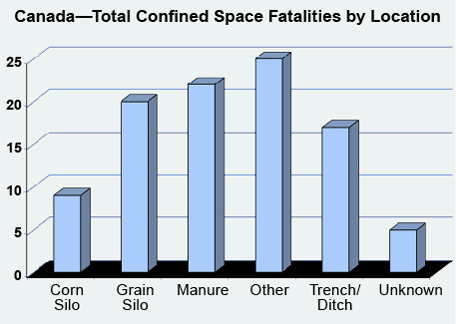Training Room 2: Keeping Safe and Healthy—Standards and Practices in an Agricultural Environment
Session 4: Confined Space Safety—Standards and Practices

Courtesy of the University of Minnesota Extension and The Canadian Agricultural Safety Association
A confined space is defined as an area with limited or restricted entry/exit points or a space that is not designed to be occupied by workers for long periods of time. These spaces often have loose materials, dust, or mechanical hazards, and may have reduced levels of oxygen or hold toxic or explosive gases.
In agricultural environments, confined spaces could include such structures as silos, grain bins, manure pits, trenches, well shafts, water cisterns, and controlled atmosphere storage structures. (Canadian Federation of Agriculture)
The hazards of a confined space can cause severe injury or death. WorkSafeBC recommends that you must follow special precautions and procedures before you enter. Even if you just put your head through the opening, you are entering a confined space. NEVER enter a confined space unless you have the training and knowledge to work safely.
Learning Target
In this training session you will learn to identify the hazards of a confined space and develop an understanding of the safety tests and procedures that should be taken to keep workers safe when working in confined spaces. Keep the following question in mind as you work through the session:
- How can tests, equipment, procedures, and training be included as part of a safety plan for agricultural work involving confined spaces?
Hazards of Confined Spaces in Agricultural Settings

Scott Fraser/Courtesy of Canadian Agricultural Safety Association
Data collected and shown in this graph from the Farm and Ranch Safety Association show what kinds of confined spaces have contributed to deaths in agricultural settings in British Columbia between 1990 and 2009.
Workers in these confined spaces can be exposed to
- toxic gases, such as nitric dioxide (silo gas), from fermentation in silos
- high carbon dioxide (CO2) and low oxygen (O2) in controlled atmosphere storage structures
- toxic gases, such as hydrogen sulfide (H2S), ammonia (NH3), carbon dioxide (CO2), and methane (CH4), in manure pits
- flowing grain in grain bins, grain wagons, and grain trucks that can engulf an adult in 20 seconds
Watch and Listen
Confined spaces on farms have similiar hazards to those found in non-agricultural settings. These video clips from Alberta's Farm Safety: It's No Accident and from WorkSafe BC illustrate the dangers of low oxygen and toxic gases for workers. They will help you understand how quickly you can be overcome in a confined space.
Testing for Potential Hazards in a Confined Space
What follows are the basic guidelines for planning to enter a confined space, according to the Farm Safety Association.
- Someone trained and qualified should test the atmosphere for oxygen and for levels of toxic and explosive gases.
- If a dangerous atmosphere exists, you must wear a self-contained breathing apparatus. Ventilate the area as thoroughly as possible.
- All mechanical and electrical equipment must be locked out.
- Use the buddy system and wear a lifeline. Sufficient equipment and manpower must be available. A third person should be on hand to summon assistance, if needed.
- Establish how you will be communicating before entering the confined space. The meaning of verbal signals, hand gestures, or tugging line signals must be understood by the people on the outside.
- Never re-enter a confined space without retesting and ventilating the area.
- If at all possible, don't work in a confined space. Change the work so that you can do it from outside the space.
Websites
For more information about safety practices for particular confined spaces, read these articles:
- Youth in Agriculture: Confined Spaces (US Occupational Safety and Health Administration)
- Work a Plan for Safety in Confined Spaces (Canadian Agricultural Safety Association)
- Guideline for Developing a Code of Practice for Confined Space Entry (WorkSafe Alberta)
Checking In
Discuss
According to statistics from the National Institute of Occupational Safety and Health, more than 60 per cent of confined-space fatalities involve would-be rescuers.
It is important to consider the need for a rescue plan if someone is overcome or injured in a confined space. Rescue workers are often injured while attempting a rescue.
To Do
- Choose one of the following two ways to find out about rescue hazards for confined spaces on a worksite:
- Talk to your supervisor on your farm. Find out what safe rescue procedures are in place in case of injury in a confined space on your worksite. Ask about training that is available.
OR
- Watch Confined Spaces: Just Calling 911 Doesn't Cut It. What kind of training do you believe is needed in a confined-space hazardous situation?
- Talk to your supervisor on your farm. Find out what safe rescue procedures are in place in case of injury in a confined space on your worksite. Ask about training that is available.
- Research where a training program for confined-space rescue is offered in your local area. Start by asking on your worksite and searching the Internet.
- Contribute your experiences to the discussion online, Confined Spaces: Creating a Plan for Safety or take part in a discussion with your classmates as directed by your teacher. Answer the following questions:
- Describe a confined-space hazard that is present on your farm and the procedures that must be followed to prevent workers from sustaining injuries.
- What recommendations can you make about the communication of safety standards for confined-space rescue on your worksite?
- Compare your situation to the experiences of another classmate.
- Describe a confined-space hazard that is present on your farm and the procedures that must be followed to prevent workers from sustaining injuries.
- If you want to demonstrate your understanding of confined-space safety in your Risk Management Tutorial Project, use the information about rescue procedures you investigate above to describe the standards and practices for confined-space safety in your workplace.